Although the Blu-ray player is becoming something of a commodity, some manufacturers are doing their best to keep the format exciting with new features, enhanced performance and improved ergonomics. Panasonic's DMP-BDT310 Blu-ray 3D Player is the company's latest top of the line player, with plenty of network streaming features, integrated WiFi, and excellent audio and video performance. Yet its price is comparable to entry-level players of just two years ago.
The Set-Up
Sometimes simpler is better. Previous players from Panasonic have offered multi-channel analog audio outputs, for compatibility with pre-HDMI home theater gear, and component video outputs for compatibility with very early analog-only HDTVs. But in 2011, you can pick up a receiver for under $300 that supports HDMI switching, including 3D compatibility and decoding of all the lossless surround codecs.
Also, HDMI inputs on HDTVs have been a standard for several years, and are a requirement if you want to do 3D. Furthermore, this year, the "analog sunset" goes into effect. This industry ruling requires that any high definition player with analog video outputs step down its component video outputs to standard definition if the content requires it. So we can hardly blame Panasonic for eliminating HD component video outputs and multi-channel analog outputs entirely this year. You get composite video, stereo analog audio, fiberoptic digital and HDMI. And this should be enough for most people.

What sets the DMP-BDT310 apart from this year's other Panasonic Blu-ray players, as well as most competitive models, is a second HDMI output. This is useful not only for those who wish to connect their player to multiple displays (e.g., a flat panel and a projector), but also for those who own HDMI-capable home theater receivers and preamps that lack 3D-passthrough capability. Rounding out the port selection on the BDT310 is an SD card slot (need to add a card for BD-Live or Skype use), two USB slots and a standard Ethernet network jack. This network port may not see much use as the BDT310 also comes with integrated WiFi networking support, all the way up to 802.11n.

For my purposes, I connected both HDMI outputs, one directly to a Panasonic VT25 series 3D-capable plasma, the other to an Integra preamp/processor. With the video output of the secondary output disabled, I had no trouble getting multi-channel lossless sound through the preamp while the display handled the video. If you're not using an external sound system or if your receiver supports 3D passthrough then one HDMI cable is all you'll need. I chose to hard-wire the network connection for highest performance, but I tested the integrated WiFi connection and that worked fine as well, streaming HD content without issue.
So Easy a Mother Could Use It
One of our biggest complaints in Panasonic's earlier Blu-ray Disc players has been their ergonomics: blocky text-based menus with multiple options that are not always intuitively obvious. Happily this year they've changed things up with a new graphically oriented "Home" screen which loads by default when you start up the player. You can even change the screen background with your own custom image if you are so inclined. Once in the Home menu, you navigate through the various options: video, music, photos, network and set-up. A tap on the directional keys on the remote brings you into the various sub-menus. It's all pretty straightforward and intuitive, and a nice improvement over previous generations.
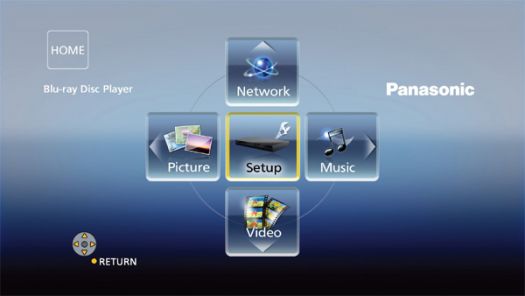
If you are looking for commonly used network features, such as Netflix or the new Skype video calling feature, you'll be happy to hear that there are direct buttons for these on the remote. Even though they've reduced the size of the remote by about 25% overall, they've added these direct buttons to make it easier to access these specific features. Of course, there's still no subtitle button on the remote, and it seems that they've also lost the "Menu" button. What? No menu button? Well fret not. Panasonic has combined the "Pop-Up Menu" and "Top Menu" into a single button. On a DVD, this takes you to the disc menu. On a Blu-ray, if there is a pop-up menu, then this is what you get but if there is not, then you get the disc menu. If you want to get to the "Disc Menu" on a Blu-ray that also has a pop-up menu, then this will take two clicks - Pop-Up Menu, then Sub-menu. Confused? You'll get used to it.
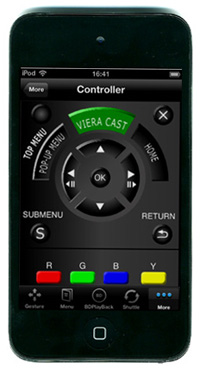
In addition to the standard remote control, Panasonic has launched a new app for the iPhone, iPod Touch and iPad that allows you to operate the DMP-BDT310 or the DMP-BDT210 right from your Apple device (Panasonic says an Android version of the control app is in the works). In addition to a full size replica of the factory remote on your iPhone screen, which requires some scrolling to view the whole thing, there are other options such as a gesture pad that allows you to swipe and tap your way through menus. What's missing, and would have been really nice is a keyboard function to help you enter things like account IDs, passwords and search terms. But even without this, the app is pretty slick, and is actually nimbler and more responsive than some other WiFi-based control apps I've used.
Faster, Pussycat
One other area where Panasonic has sometimes lagged behind the competition is in its boot-up and disc loading times. But with this year's crop of players, Panasonic is back out at or near the front of the pack. From fully powered off, you'll get to the splash screen in about a second with "QuickStart" mode enabled or 16 seconds with it off. Once you're up and running, disc loading is not likely to draw too much attention to itself, and that's a good thing. A standard DVD (Gladiator) loads to its Paramount logo in about 17 seconds. A basic Blu-ray (Resident Evil: Apocalypse) loads to the Sony logo in about 15 seconds and a Blu-ray packed with BD-Java (Pirates of the Caribbean: Curse of the Black Pearl) gets past the spinning coins to the Disney logo in an impressive 28 seconds. These are all noticeably improved over the 2010 players and up there among the fastest players we've tested.
There are a few discs that still take some time to load, notably those with heavy amounts of BD-Live content embedded into their menus. This content must be downloaded from the Internet in order for the disc menu to load. Inglourious Basterds is one such title, taking a full 101 seconds to load to the menu (though a second load of the disc shaved this down to 82 seconds). If you're in a hurry, you can either disable BD-Live or turn off your network connection on the player prior to loading the disc, and then you'll get to the menu in about 56 seconds, but you will probably get annoying messages saying your network connection is unavailable. This particular title is one that we've seen bring earlier players to their knees so it's encouraging to see Panasonic continue to shave some time off the disc loading times.
I Stream, You Stream
With CinemaNow the only new streaming service, Panasonic hasn't added much to its audio and video streaming service line-up in 2011. VUDU was actually delivered in a firmware upgrade to the 2010 Blu-ray 3D players. This service offers very high quality streaming with 1080p resolution and 5.1 channel surround, but Panasonic's VIERA Cast implementation of VUDU does not yet support 3D movies in VUDU (Panasonic hopes to add support for this soon). But the player's VIERA Cast offering already had pretty much all of the essentials, including Netflix, Amazon VOD, VUDU, Pandora, YouTube and Picasa, plus Fox Sports, Twitter and everyone's favorite German language news service Tagesschau. But Panasonic has taken what services they already had and made them better.
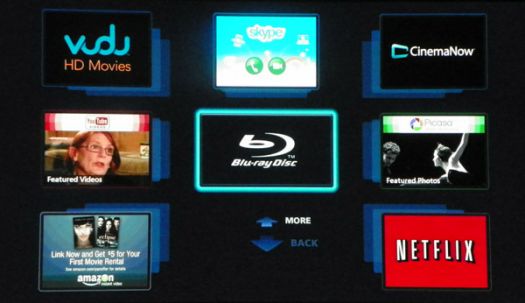
Most noticeably, the Netflix interface is now the 3.0 version, which allows you to browse and search for new titles, instead of being limited to viewing titles already in your instant queue, as on previous players. Netflix now also supports 5.1-channel Dolby Digital Plus surround, which we verified as working properly on compatible titles such as the creepy Swedish vampire flick, Let the Right One In and the sort of indie sci-fi pic, Monsters. But even better, Panasonic has redesigned their UniPhier video processor to apply its full scaling and chroma upconversion to streaming sources. This means that streaming content on Netflix, Amazon, even YouTube, benefits from Panasonic's UniPhier video processor. Does it make standard def streaming sources look like Blu-ray? Well, no, but it's a big improvement over last year's players.
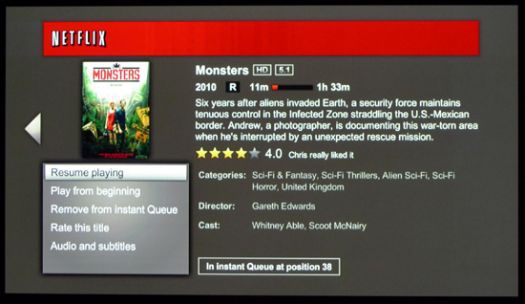
One of our knocks against last year's DMP-BDT100 and DMP-BDT350 Blu-ray 3D players was their handling of stand def streaming material on Netflix due to an issue known as the chroma upsampling error (CUE). As an example, the opening scene from episode 13 of the Sci-Fi series "Farscape" features a difficult scene redolent with deep red roses and sheets, bordering a lighter background. On last year's players, the red borders were jagged and rough due to the CUE issue. On the BDT310 there were no such artifacts. We did notice some black frames appearing on Netflix streaming content at times, when the network speed varied, but this did not appear on all content nor at all times. Panasonic tells us this is something that they are investigating.
While details of standard def streaming material on Amazon, VUDU and Netflix are still softer than DVD, the edges are much cleaner and overall picture quality is noticeably improved over previous players. Also, with the video processor now available for streaming sources, you can adjust picture processing parameters such as chroma processing, fine detail and Super Resolution in the player's "Display" menu applying just the level of detail enhancement you like. Bottom line: if you're a fan of online video streaming, the new Panasonic players make an excellent choice.
ET Phone Home!
One of the cool new additions to the 2011 Blu-ray players from Panasonic is the Skype video-calling feature, previously available from Panasonic only on select VIERA HDTVs. Now, with the addition of a compatible Skype webcam (such as Skype's FREETALK HD Webcam for Panasonic TVs and Blu-ray players), you can use the BDT310 to turn any TV into a big screen video phone, calling other Skype users for free. You can call pretty much anyone who has Skype anywhere in the World, whether they're on a PC, Mac, smartphone or another TV or Blu-ray player (and vice versa). If you call another Panasonic Skype user, then you can see them (and they can see you) in all their (your) widescreen high definition glory. Two things: a.) make sure you are wearing pants when accepting a call (particularly if you're a congressman from New York); and b.) be sure to keep the living room clean -- I thought ours was fairly tidy until I viewed what it looked like through the attached Webcam: those magazines and kids' toys seem to proliferate in high definition!
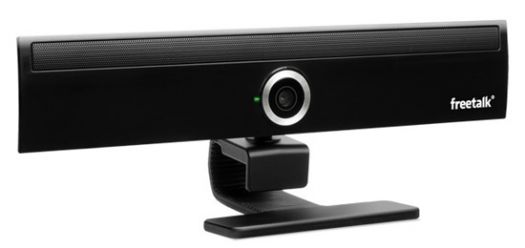
The Skype video calling app works as expected, allowing you to make video calls to other Skype users. One nifty new feature is the ability to receive and store video voice mail messages when you are unavailable. You will need an SD card in the player to use this feature. And since video clips tend to take up a bit of storage, we'd recommend getting an SD card at least 4GB in capacity (this storage is also shared for BD-Live).
Get Higher, Def
Turning standard definition sources into something suitable for display on a high definition TV or projector is no mean feat. Any Blu-ray player can turn DVDs into 1080p but few really do it well. Reconstructing those missing pixels and color detail is almost a black art. The player has to make some educated guesses on what was originally in the picture in terms of color information and overall detail. The DMP-BDT310 builds on Panasonic's tradition as a solid provider of upconversion, scaling and chroma processing with some additional enhancements over earlier models.
Looking first at the old standard "HQV Benchmark" DVD, we tested the player's ability to deinterlace the 480i DVD test patterns and scale them to 1080p resolution. The standard def color bar pattern resolved all of the available detail cleanly and with smooth color transitions. Jaggies test 1 with its white spinning bar was clean with only a hint of shimmer right as the bar reached horizontal and test 2 had only a mild amount of stair-stepping on the lowest of three moving which bars. Similarly the waving flag test showed solid detail in the bricks and no evidence of stair-stepping in the flag itself. These three tests show that the player had very good to excellent diagonal filtering.
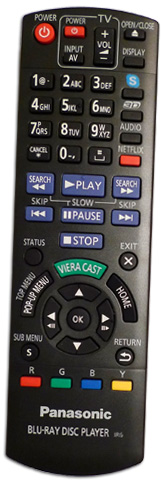
In cadence testing, the player locked to the 24 fps test signal in the "Super Speedway" clip quickly, eliminating the moiré pattern in the grandstands in less than a second. It also represented the tricky mixed cadence test (scrolling video titles on a film background) with just a shimmer of combing in the scrolling horizontal text at the beginning. Mixed cadence testing revealed some minor jaggies in some of the less common film/video cadences.
Moving on to some HD image testing on the HQV Blu-ray Disc, the player handily passed both the video detail and film detail tests, resolving single pixel high rows in a 1080p test pattern. This shows that the player has no problem decoding both a 3:2 cadence (24 frame/second film source) and a 2:2 cadence (video source) on a 1080i signal. Watching one of the few 1080i Blu-ray Discs in our collection ("Legends of Jazz") reinforced this observation, with clean lines, free from jaggies and excellent borders between colors.
On the Spears and Munsil test disc, the chroma zone plate test looked as clean as I've ever seen it, free from jagged lines on the alternating colored rings. Cadence detection on the common tests (2:2, 3:2) looked fine, though there was some moiré on the less common cadence tests. In a nutshell, the player performed extremely well on all the test patterns and that mattered. Those who watch their movies on silver discs, be they DVD, Blu-ray or Blu-ray 3D, will be well served by the performance on this player.
And this performance carried over to real world content as well. Although Gladiator and The Fifth Element are now available on Blu-ray, we still use the DVDs for testing certain aspect of upconversion and de-interlacing. In the opening sequence in "The Fifth Element," the archeologist's beard shows nice detail and the later "Diva" sequence has plenty of pop to the colors. In "Gladiator," the Coliseum flyover sequence in chapter 12 shows strong diagonal lines, with no trace of jaggies. Moving onto Blu-ray, the Baraka disc (which was mastered at a phenomenal 8K resolution in preparation for its Blu-ray release), reveals exquisite details of natural landscapes. A tiny rivulet of molten red-orange magma flowing atop an active volcano stands cleanly out against the scorched rock background. Fine color detail such as this can be difficult to reproduce, particularly on a large projection screen, but it looks exceptionally natural and detailed here.
Entering the Third Dimension
As for Blu-ray 3D playback, we tested a number of discs including Avatar (Panasonic exclusive), Despicable Me, Tangled, Grand Canyon: A River at Risk. All played properly and reproduced a convincing illusion of 3D when connected to a Panasonic VT25 series 3D-ready plasma HDTV. I noticed no instances of crosstalk or other artifacts introduced by the player. There are also various 3D settings you can adjust in order to enhance or reduce the depth of the 3D effect (helpful for compensating for "bad" 3D content), or play with the way the 3D effect is handled toward the edges of the screen. But on well-produced 3D content, I left these settings alone. There is also a 2D to 3D conversion feature which is interesting to try on various 2D content (it can work pretty well on some titles such as animation). Again, I didn't spend too much time with this as frankly, I'd rather watch 2D movies in 2D rather than have some pseudo-3D effect. Studios spend millions of dollars to convert 2D content to 3D, with sometimes substandard results. Do you really think a $200 Blu-ray player will be able to do this any better?
It's also nice to see that Panasonic continues to offer alternate 3D output options (checkerboard and side-by-side). These are less relevant now that Mitsubishi has built Blu-ray 3D compatibility directly into their latest line of 3D DLP TVs, and side-by-side-only 3D displays are also fairly rare. But for those who do own one of these alternate-style 3D displays, it's nice to have the option for compatibility. Some buyers of this player may never use the 3D playback features, and some may use it only rarely, but for those who like 3D, the Panasonic BDT310 is about as high performance and flexible as you can find for Blu-ray 3D playback.
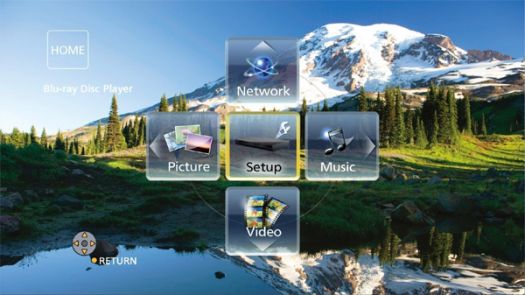
A Few Words About Sound
Something that the Panasonic Blu-ray engineers spend a great deal of time and thought on is the sound quality. The DMP-BDT310 is no exception. The BDT310 includes a feature from the 2010 players called "High Clarity Sound" (also on the BDT210). This disables the analog video processing so that it won't interfere with the audio circuitry. Also, built into all of this year's Blu-ray 3D players is something called the Pure Audio Jitter Purifier; this feature re-clocks the digital audio signal with a more stable master clock so that the resulting HDMI output will be decoded more accurately by your receiver or preamp/processor, whether you use the bitstream output or PCM output.
Other unique features on the Panasonic Blu-ray players are a 96KHz Audio remaster which effectively "upsamples" the audio soundtracks to 96 KHz sampling, also applying some equalization to enhance the sound. And, if you're a fan of that warm vacuum tube sound, you might want to play around with the Digital Tube sound options in the player. These six sound modes are intended to emulate the sonic characteristics of various kinds of vacuum tubes. Panasonic doesn't publish which tubes are modeled by each mode but makes the following recommendations of which mode to use for which type of music:
For me, I usually keep things as neutral as possible so I did not spend too much time experimenting with these modes. But as an owner of a tube power amp, I definitely see the appeal of tube emulation modes to add warmth to that pristine digital sound. It's certainly worth playing around with to see if you like the effects.
OK, What did I Miss?
With all the features and options that the DMP-BDT310 proffers, it's hard to imagine that something might be missing. But there are a few things that went away in this generation, some of which no one will miss and some of which some might. I already mentioned the lack of multi-channel analog audio and component video outputs, but these aren't going to be missed by too many customers. What I do miss in this year's players (and which took me some time to figure out was missing) is AVI video file playback, from a local USB drive or streamed from a local PC.
The unit does offer DLNA support for streaming videos, audio and photos from a local DLNA-compliant server device, but if you have any AVI format video files (which use the Divx or XVid codec), the player will not recognize these and will not even show that they exist. This occurs whether you stream from a DLNA device or try to play the files from a directly attached USB thumb drive. Panasonic did add MKV file playback, but a couple of test files I had in this format would not play (probably due to incompatible codecs). Does the lack of Divx support matter to the average consumer? Maybe not. Divx and Xvid codecs are normally used by more advanced hobbyists who create their own video content or download videos from sites such as WBshop.com and FilmFresh.com (among others). If Divx support is important to you, then the these are not your best choice, but for everyone else, Panasonic's 2011 Blu-ray 3D players should be at or near the top of your list.
Turn Ons
Turn Offs
Final Thoughts
Panasonic definitely has a winner this year in the DMP-BDT310 Networked Blu-ray 3D player. It offers fast disc loading, a nicely improved user interface, a solid selection of streaming sources and apps, and excellent audio and video performance. The lack of Dvix/XVid support and limited MKV playback support was a disappointment to me (and rules it out for my own purchase) but may not be noticed by many consumers. If you don't need the second HDMI output, then you can save a few dollars and get the DMP-BDT210, and if you don't care about WiFi or iPod/iPhone control, then check out the wired DMP-BDT110. All three players offer similar performance and all three make an excellent investment for your media playback dollars.
Manufacturer's Specifications:
Manufacturer's Contact Information:
Panasonic Corporation of North America
One Panasonic Way
Secaucus, NJ 07094
1-800-211-PANA (7262)
Web Site: www.panasonic.com
Where to Buy:
| Overall | |
|---|---|
| Value | |
| Performance | |
| Features/Ergonomics |